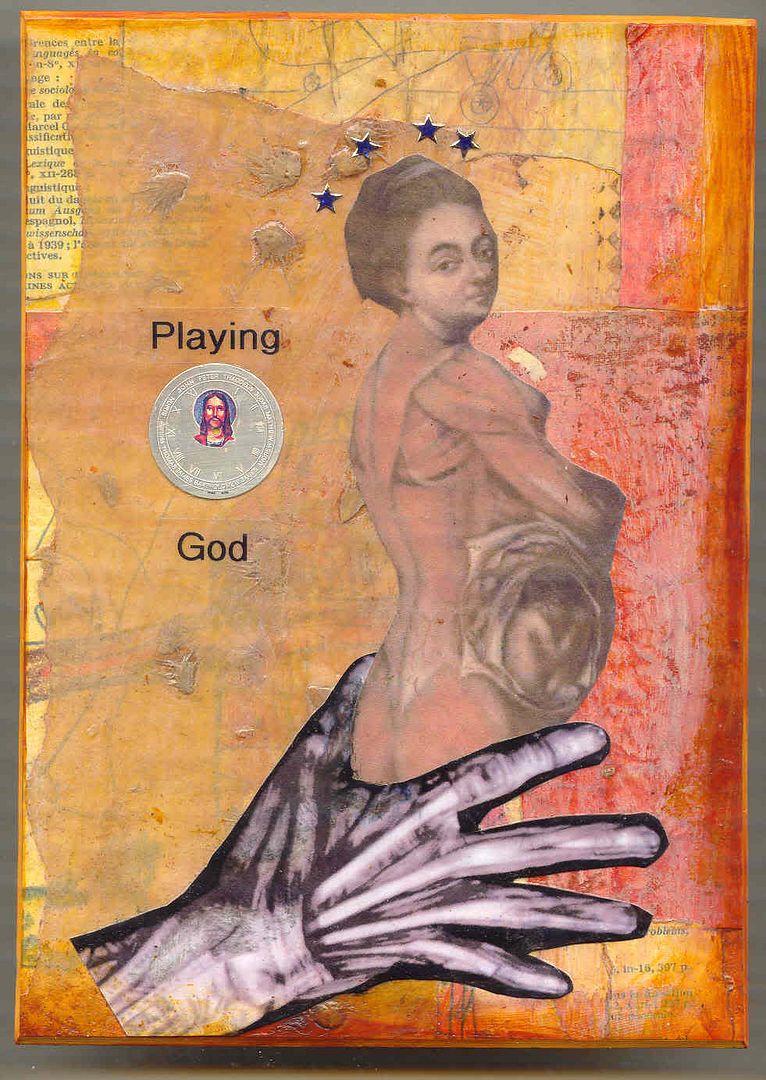
Today I have a little more time. My 11 year old son had a friend over yesterday to celebrate his birthday and well we were hoping again as usual. I had no time for profound thoughts (LOL). So hopefully today I will finish Jonathan Talbot's reply to the challenge he gave me.
This collage was also done in Jonathan's workshop at the beginning of April. This one used his methods which are described in his book "Collage, A New Approach." If you are interested in a copy you can purchase one via his website or attend a workshop and get one as part of the class. I often find myself making political and moral statements through my work. I doubt this piece will ever sell because of the nature of the it. I did need to make this statement and I think it had been brewing inside me for some time. For whatever reasons, it just spilled out of me at this workshop. I call the piece "Choices."
KL: "Your paintings and your body of work makes your statement, be it personal, social, political, or philosophical as my research and publications make mine. Am I onto something here?"
JT: "What I think you are moving toward is the realization that YOUR visual artwork will make your statement in the future just as your research and publications (and professional relationships) did in the past... and professional relationships will be important in the artb world as well."
KL: "No wonder I am in the process of exploring my own creative expression.
JT: "No, there is no surprise in it... You are, because of your experience set, particularly well equipped for this explorative process."
KL: "As for more concrete relations between the visual arts and microbiology...here is one microbiologist's perspective....."
JT :" I enjoyed you making a painters palette out of Eosin, malachite green, carmine, gentian violet, fuschin, and methylene blue. Do you know that during the renaissance most artists manufactured their own paints (they did not, however, always grind the pigments as there were others who did that... but the artists tended to buy the pigments as powders)."
KL: " Clusters of grapes, spiderous shapes, four leaf clovers, worms, chains, corkscrews, and threads ... a variety of colonial morphologies [such] as cavernous, volcano like, mesas and mountain ridges, milky ponds, slick ice patches, snowflakes, and wispy cotton candy. I once remember thinking that I was looking at a southwest landscape. The petri dish contained rich hues of sepia, burnt sienna, raw umber and colonies took on the shape of giant mesas."
JT: " The basic shapes of microbiology are not so different, it would appear, from the plane, cube, cone, and cylinder of the first year composition class... "
KL: " Mold and filamentous type organisms offer perhaps the greatest arrays of color and shapes that I have ever seen. These organisms are often highly pigmented and beautiful shades of greens, blues, yellow, reds, and browns can be observed. The pigments are rich and often are secreted into the growth medium making for an even more spectacular show. The color are sometimes surreal, fluorescent, iridescent... and always spectacular. Colony morphology is as varied as the color and can be described as great craters (like the moon craters), cauliflower heads, fluffy cotton balls, and waves (like the ocean)."
JT:" This passage sounds like a review in Art News!"
KL: " Finally, the way I approached my research should serve me well as I explore the visual arts. Experiments were planned based upon current theories, very carefully, and methodically. It was however, with a bit of serendipity and a I don't give a damn what others think attitude (of course when things weren't going well), that the most satisfactory results were obtained. "
JT: " Well said.."
KL: "Although I have no formal training in the arts... that will not hinder my process but rather challenge me to go forward. "
JT: " Since you have already acquired one formal disicipline (microbiology) and became (I quote from your message) "a sought after trainer because of [your] skills" you now have what you need to acquire formal knowledge in a new disicpline (plastic or visual arts). The knowledge is there, the trainer is there (you), the student is there (you), colleagues are there (artists everywhere, those living and those who have gone before, leaving their work behind), mentors are there (you will find them)."
KL:" In closing, I don't know if this piece is what you were looking for but it is what I was looking for. For me this has indeed been a revelation, a closure and a new beginning all in one!
JT: "Of course what I was looking for had more to do with process than product. But as I understand the process by which you put the "dissertation" together, and as I read the results of that process, there is a sense of satisfaction and I am grateful to you for it."
KL: " My work is for me now and may always be [a revelation, a closure and a new beginning all in one!] "
JT: " This single sentence is enough to form a firm foundation for a lifetime of work... May I quote you?"
Cordially, Jonathan
And so there you have it. Jonathan is a remarkable artist, capable of greatness. But more wondrous to me is what a remarkable human being he is. He read my little dissertation and put thought into a response, one that he knew instinctively, would be very, very important to me. Jonathan, if you are reading this, I thank you again for taking the time to indulge me. You words have made, and still continue to make, a difference in how I approach my art and my life.
K

No comments:
Post a Comment